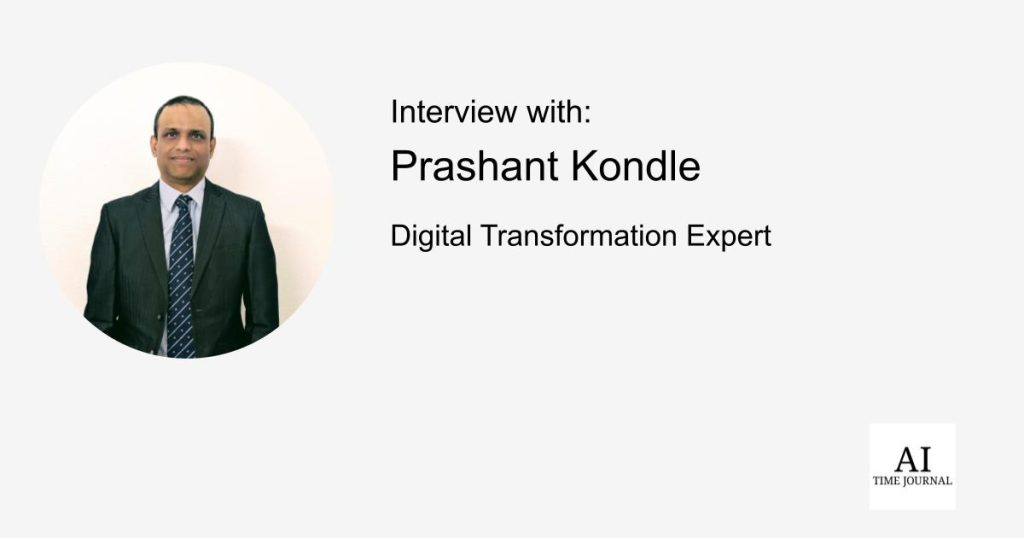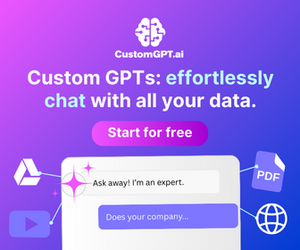[ad_1]

In this interview, we speak with Prashant Kondle, a digital transformation expert with a cross-industry track record in healthcare, aerospace, and financial services. Prashant shares how compliance can drive, not hinder, AI innovation, why most digital transformations fail to address real operational problems, and what startups often overlook when building AI products. From supply chain resiliency to explainable AI, his insights offer a grounded, systems-level view of what it takes to lead transformation at scale.
Explore more interviews: Keaun Amani, Founder & Chief Executive Officer at Neurosnap Inc. – Leading the Integration of Software Engineering and Molecular Biology: Transforming Bioluminescent Challenges into Breakthroughs with AI
How do you balance innovation with compliance when introducing AI-driven solutions in highly regulated industries like healthcare, aerospace, and finance?
In highly regulated markets, like healthcare, aerospace, and financial services, innovation is a disciplined process — following the rules isn’t an afterthought; it’s built into every step. Every concept is examined for compliance from the beginning to the end. That’s why I consider following the rules a fundamental design principle, incorporating standards like HIPAA, ITAR, or GLBA into the development process to prevent rework and delay downstream.
Conformance is ongoing, and in those industries, it gives you a strategic edge. Because everyone is following the same rules, your ability to move quickly and react is based on how well compliance is embedded in your innovation pipeline. The more sophisticated and integrated your processes are, the quicker and more confidently you can bring AI solutions to market that meet both business needs and regulatory requirements.
I realize that in strictly regulated domains, data privacy, protecting intellectual property, and locking down systems are of utmost significance. Institutions move cautiously and prefer to keep vital systems protected to limit risk. That is why every single AI solution needs to be transparent, verifiable, and justifiable at every stage, not simply for compliance with rules but to build confidence in internal stakeholders and end users as well.
This is backed by cross-functional cooperation, involving legal, compliance, and subject matter experts at the start of the development process to flag possible red flags and align with evolving standards. My approach to innovation is risk-based, starting with lower-risk, higher-impact use cases and expanding responsibly as the system proves to be reliable.
I consider compliance not as a limitation, but as a way to enable responsible innovation. It enables us to create AI solutions that are advanced, secure, able to adapt, and sustainable over the long run.
What are the biggest misconceptions companies have about digital transformation, and how do you guide them through the reality of implementing AI and automation?
One of the greatest misconceptions is that digital transformation is just a tech refresh delivering efficiency. Many think that adding AI or automation software will somehow magically yield a better return on investment. In actuality, transformation is a change in how an organization works, and that takes changes in process, use of data, and decision-making. I’ve written extensively about this in publications like Forbes, IEEE, and academic journals. My point is that technology, by itself, not tackling the real problems in operations, usually doesn’t lead to real change.
A second myth is that AI is just a matter of setting something up and turning it on. In industries like healthcare, aerospace, and finance, AI has to fit into different modes of working, compliance, and people interaction. In my leadership ideas, I stress the importance of transparent, informed, and explainable A.I., which engenders trust as it addresses real problems — this has informed my work across different industries.
A crucial yet overlooked fallacy is blind first-principles thinking. In my IEEE paper, I caution against trying to recreate systems from scratch with no regard for legacy infrastructure, cultural resistance, and human dynamics. It typically ends up re-creating the same inefficiencies using new tools. Change programs falter when they neglect that process flaws are rarely, if ever, just technical — they are human and organizational. That’s why I’m a believer in incremental, feedback-driven transformation grounded in operating reality, not hypothetical reinvention.
To assist organizations in tackling challenges, I view transformation as a process to develop skills, not an episodic project. I recommend beginning small, dedicated trials and ensuring every effort links to specific results before scaling up. Only when they are all aligned and prepared do I let them scale. I also engage leaders to shift the perception that transformation is reserved for the IT group alone. True change occurs when business owners, compliance groups, and operators equally own the solution.
Last but not least, I help companies reinterpret digital transformation as a strategic, iterative process — one that yields adaptive, data-driven operating models. That’s the message I’ve consistently delivered through both my written output and direct implementation in target industries. In the end, Digital is one aspect of transformation, true transformation happens when people, process & thinking transform.
With your experience in process optimization, what’s a common inefficiency in enterprise operations that AI can solve but is often overlooked?
A major inefficiency lies in organizations’ tendency to optimize existing tasks without questioning their necessity. Many enterprises look to AI for quick wins — automating repetitive processes or accelerating decision cycles — but they rarely ask: Should this task exist at all? AI’s real potential isn’t just in making processes faster, but in challenging the operational logic behind them.
In my experience, transformation happens when AI is not just used for execution, but also for diagnosis and reflection. For example, using unsupervised learning and process mining, we can surface patterns that reveal redundant approvals, outdated checks, or legacy tasks that persist simply because “that’s the way it’s always been done.” These inefficiencies are often blind spots to the most involved teams.
This connects directly to another blind spot: the informal or “shadow” process — the way work actually gets done through backchannel communication, spreadsheets, and ad-hoc workarounds outside the formal system. AI, especially when trained on unstructured data like email logs, chat threads, and workflow metadata, can illuminate these informal channels, exposing the actual bottlenecks and enablers of operational flow.
Most change programs never address these latent inefficiencies because they are not visible in system-of-record data. However, once revealed, AI allows us to redesign processes from empirical behavior, instead of theoretical process maps. I’ve seen this approach shrink cycle times, eliminate unnecessary handoffs, and lower exception handling.
In short, AI shouldn’t just automate what we already do — it should help us rethink what’s worth doing in the first place. That’s where the deepest, longest-lasting efficiency gains are to be had.
How do you approach the challenge of scaling B2B SaaS products while ensuring they remain adaptable to evolving regulatory requirements?
Regulatory adaptability doesn’t begin after you’ve found product-market fit — it starts from day one. One of the most common pitfalls in SaaS scaling is treating compliance as a bolt-on once traction arrives. By then, it’s often too late — architecture must be refactored, workflows reworked, and UX redesigned under pressure. Instead, I believe regulatory awareness must be baked in from the start, with product architecture, data governance, and auditability as foundational capabilities, not afterthoughts later on.
Second, UI/UX should reflect the regulatory consciousness of the product. A compliant system is not just secure at the back end, it reminds the user of their responsibility. By showing unambiguous workflows, contextual prompts, permission-aware interfaces, and embedded policy transparency, the product must prod the users towards compliant behavior. This reduces the friction, risk factor and builds a culture of trust without overwhelming the user.
Third, true scalability under regulation is dependent on configurability. Different customers — startups or companies, healthcare or defense, need different regulatory obligations. An inflexible compliance layer is a blocker. I build systems with modular controls, flexible role-based access, data retention policies that can be configured, and policy-driven workflows, so that the platform can scale without code-level customization.
Together, this approach — early compliance design, user-level regulatory direction, and system-level configurability — enables SaaS products to scale industry and geographically while being audit-ready. It’s not just about fulfilling today’s requirements — it’s about building a system that can evolve to meet tomorrow’s.
Having worked across multiple industries, what lessons from one sector have you successfully applied to another in your approach to product development?
One of the most formative lessons was from my time in healthcare, where I acquired a security- and privacy-first mindset. In healthcare systems, protecting patient data isn’t just a technical requirement — it’s an ethical and regulatory requirement. This background taught me to architect systems with zero-trust principles, granular access controls, and built-in auditability from the very beginning. I’ve carried that rigor directly into my work in aerospace and defense, where protecting sensitive data, safeguarding IP, and ensuring traceability across the product lifecycle are just as critical. The result is products that aren’t just compliant — they’re resilient under scrutiny and trusted in high-stakes environments.
I gained from financial services the importance of operational discipline and process-driven scale. I led a compliance-driven, high-volume operational organization where success was based on predictability, clean handoffs, and metrics-driven execution. I later applied the same rigor to transform retail workflows, creating systems that could handle variable demand, regional diversity, and complex supplier networks, with consistency and accountability. That cross-fertilization enabled us to build retail platforms that scaled regularly and operated in a range of regulatory and geographical conditions.
Across every domain, I’ve found that success lies in translating deep lessons — whether about security, process, or human behavior — into new contexts. That’s what enables me to build products that are not only innovative but also grounded, scalable, and execution-ready.
What role does AI play in improving supply chain resiliency, and what are some of the most exciting applications you’ve seen or worked on in this space?
AI is the catalyst that transforms supply chains from reactive, rule-based systems into adaptive, self-healing networks. Instead of relying on historical forecasts, AI provides real-time visibility, anomaly detection, and predictive intelligence to operational data, so teams can forecast disruptions, quantify risk, and trigger automatic corrective action before issues propagate downstream.
One of the most powerful applications I’ve seen is the use of AI-powered digital twins. These systems create a live, virtual replica of the end-to-end supply network, enabling teams to simulate scenarios—whether it’s a port shutdown, supplier delay, or sudden demand surge—and evaluate remediation strategies in seconds. This not only accelerates crisis response but feeds a continuous learning loop, making the supply chain smarter over time.
I touched upon this concept in my Forbes article, “The Cognitive Supply Chain: Building Self-Healing Networks Through Digital Transformation,” where I explained how digital twins and AI-powered orchestration levels can identify the early warning signs of disruption, recommend the optimal reroutes, and even make low-risk decisions on their own. The outcome is a supply chain that not just withstands volatility but learns from it, adapts accordingly, and emerges stronger.
You’ve authored research on AI applications in billing workflows and cybersecurity frameworks. What emerging AI trends do you believe will have the biggest impact on business process automation in the next five years?
One of the largest trends is the movement away from task automation and towards decision-driven orchestration. In my own work on billing workflows, I demonstrated how AI can transcend the automation of individual tasks, e.g., validating claims or extracting data, to intelligently manage exceptions, value-based work sequencing, and workflows’ real-time adaptation. This is a shift from automation for efficiency to automation as a dynamic operational intelligence.
Second, AI is rapidly surfacing in its ability to monitor compliance with processes, standards, and regimes of regulation, operationally as well as from a governance viewpoint. Instead of relying on either post-hoc audit or rules-based compliance checks, AI is able to monitor behavior in real-time now, detect violations of prescribed procedure, and flag up risks early on. This has significant consequences for sectors such as defense, healthcare, and finance, where active compliance monitoring will become paramount as regulation outpaces systems.
Third, I see AI playing a transformational role in creating dynamic, unstructured repositories of knowledge derived from documents, dialogue, system logs, and SME exchanges. These bodies of knowledge can power context-dependent training, onboarding, and decision support for staff. Instead of dry guides or rigid SOPs, groups can be provided AI-curated, in-the-trenches guidance that reflects how things get done, reducing ramp-up time and investing difficult-to-document expertise.
Together, these trends portend a future in which AI is not merely automating work — it’s watching how work gets done, making sure it meets changing standards, and amplifying organizational understanding along the way.
How do you foster a culture of innovation within teams while ensuring alignment with business goals and regulatory constraints?
I believe innovation is of value when it comes to fruition. An idea with a proof-of-concept is not true innovation. Transformational work that complies with organizational, industry & regulatory requirements is innovative. My approach is to give teams a sense of what remains the same — business goals, regulatory demands, system constraints — and then push them to explore what can be done inside that constraint. It’s not about unfettered freedom; it’s about focused problem-solving.
A strong culture of innovation is fostered when teams have a sense that their ideas matter. Therefore, I support shipping innovation, not big, expansive concepts that never ship, but a series of useful, high-impact changes individually that each drive change. I tell my teams: don’t be obsessed with that one idea that transforms everything — be obsessed with the ten that ship and stick. That’s how transformation gets done.
In highly regulated environments like defense or healthcare, this mindset is especially important. I advocate for taking compliance, legal, and ops along early — not to kill innovation, but to design within constraints early. It saves waste and accelerates adoption.
We run tiny, low-friction pilots to test new concepts, not just for technical feasibility but also for scalability, usability, and auditability. It builds an over-time system where innovation isn’t episodic — it’s how we operate.
In short, I foster innovation by creating intense concentration, clear boundaries, and rapid feedback, and by rewarding ideas that don’t necessarily sound correct but do have an impact.
In mentoring startups, what common pitfalls do you see among early-stage tech companies trying to build AI-driven products?
One of the largest traps I see is that AI is leading early-stage founders to skip the basics, specifically around problem discovery, customer needs, and product–market fit. Teams are applying AI to analyze user behavior or generate product insights, but they’re not talking to real customers nearly enough. No model will replace first-hand discovery conversations, rough pilot rollouts, or learning from agonizing user feedback. Startups will end up building technically impressive products that don’t solve meaningful problems.
Second, there’s typically a lack of attention to data quality and lifecycle. Founders don’t appreciate how much time is invested in sourcing, cleaning, labeling, and maintaining data up to date, and how important that is to the product’s long-term success. They focus on model architecture before the input layer is even determined.
The third issue is in building AI in silos, without considering explainability, integration, and the human-in-the-loop case. Usability and trust would become more significant than model accuracy in healthcare, finance, and ops-dense applications. AI systems that users can’t understand, control, or act on will not be used.
My advice is always: start with the problem, not the model. Think about your ideal customer profile, problem set & how you can scale within that space. This remains true for any startup.
If you had unlimited resources to tackle one major challenge in AI and digital transformation, what problem would you solve first and why?
One of my areas of strongest interest is resiliency and transparency in the supply chain — an item high on the agenda of nearly every manufacturing firm today. But resiliency can’t be built in isolation. A supply chain is a system of interdependent organizations, and its resiliency relies on the weakest link, not just the most advanced participant.
The reality is that the majority of manufacturing suppliers, especially small ones, lack the structured data, digital infrastructure, or skills to be involved in AI-based ecosystems. That renders end-to-end visibility and coordination nearly impossible. OEMs and large enterprises can spend billions on AI, but their upstream and downstream partners are often in silos, employing manual workarounds or legacy tools.
If I had unlimited budgets, I’d put even tiny manufacturing facilities onto a digital roadmap so they can plug into the broader supply chain with lightweight, interoperable AI tools. This wouldn’t be about dashboards, this would be about helping them structure data, roll out standard procedures, and hook into upstream-downstream workflows in real time.
Correcting this would release true resiliency, not just at the organizational level, but throughout supply chain networks. And that’s the shift that actually moves the needle on systemic risk and business continuity.
[ad_2]



Leave a Reply